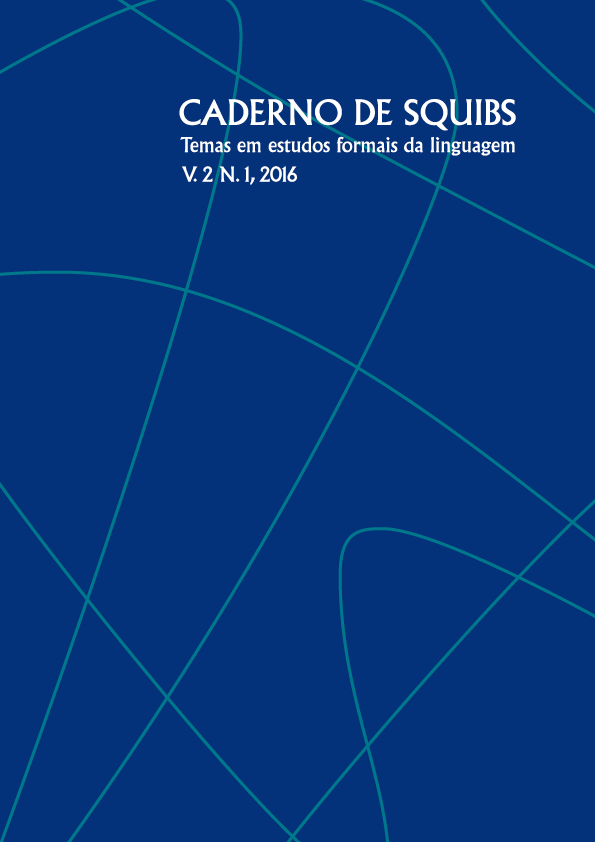Remarks on the complexity of gender
Palavras-chave:
Gênero, Categoria gramátical, Complexidade de traçosResumo
Este squib apresenta alguns aspectos da natureza da complexidade de gênero e como isto pode ser concebido ao longo da literatura linguística. Damos ênfase em dificuldades empíricas que precisam ser consideradas ao se acessar a natureza de gênero como uma categoria na gramática. Nossa meta é discutir a manifestação morfossintática de gênero como um traço (complexo), com foco nas dificuldades em defini-lo como um traço tradicional. Visto que gênero pode ser definido como um sistema de classes de concordância (CORBETT, 1991), concordância e o critério usado para se decidir quantos gêneros uma língua tem, e quais nomes pertencem a cada gênero. Mostramos algumas propostas correntes sobre a manifestação formal e funcional de gênero nas línguas, com o objetivo de descrever seu comportamento e possíveis consequências para a sintaxe desta categoria. De acordo com Kramer (2015), gêneros natural/biológico e arbitrário tem a mesma natureza pré-sintática, sendo a derivação a responsável por diferencia-los pós-sintaticamente. Entretanto, a classificação de tal categoria como biológica e/ou arbitrária levanta uma importante discussão sobre como este processo determina a distribuição e a interpretação semântico-pragmática de tal estrutura, levando em conta, por exemplo, o conhecimento de mundo do falante. Esta complexidade, todavia, pode ser interpretada por meio da computação de gênero.
Downloads
Referências
AUDRING, J. Gender assignment and gender agreement: evidence from pronominal gender languages. Morphology, v. 18, 2009, p. 93-116.
AUDRING, J. Gender as a complex feature. Language Sciences. Special issue: Exploring grammatical gender, v. 43, 2014, p. 5-17.
CORBETT, G. Gender. Cambridge: Cambridge University Press, 1991.
CORBETT, G. Agreement. Cambridge: Cambridge University Press, 2006.
CORBETT, G. Number of Genders. In: DRYER, M.S.; HASPELMATH, M. (eds.). The World Atlas of Language Structures Online. Leipzig: Max Planck Institute for Evolutionary Anthropology, 2013. Available at: http://wals.info/chapter/30. Accessed April 4, 2016.
CURZAN, A. Gender Shifts in the History of English. Cambridge: Cambridge University Press, 2003.
CYRINO, J. P. L.; ARMELIN, P. R. G.; MINUSSI, R. D. On the encyclopedic knowledge of gender. In:AUDRING, J.; KOUTSOUKOS, N.; MASINI, F.; RAFFAELLI, I.Morphology and Semantics. MMM9 On-Line. v. 1, 2013, p. 77-87.
DUKE, J. Gender reduction and loss in Germanic: the Scandinavian, Dutch and Afrikaans case studies. In: N ̈UBLING, D.; DAMMEL, A.; K ̈URSCHNER, S. (eds.). Kontrastive germanistische Linguistik. Vol. II. Hildesheim: Georg Olms, 2010, p. 643-672.
ENGER, H.-O. The role of core and non-core semantic rules in gender assignment. Lingua, v. 119,2009, p. 1281-1299.
HELLINGER, M.; BUßMANN, H. Gender Across Languages: The Linguistic Representation of Womenand Men. Vol. 3. Amsterdam: John Benjamins, 2001.
HENGEVELD, K. Introduction: transparency in functional discourse grammar.Linguistics in Amster-dam, v. 4, n. 2, p. 1-22, 2011.18
KRAMER, R. Definite Markers, Phi Features and Agreement: a Morphosyntactic Investigation of the Amharic DP. Doctoral Dissertation, University of California, Santa Cruz, 2009.
KRAMER, R. The Morphosyntax of Gender. Oxford: Oxford University Press, 2015.
MCHOMBO, S. The Syntax of Chichewa. Cambridge: Cambridge University Press, 2004.
MILLS, A. The Acquisition of Gender: A Study of English and German. Berlin: Springer, 1986.
MOORE, S. Grammatical and natural gender in Middle English. PMLA, v. 36, n.1, 1921, p. 79-103.
RESCHER, N. Complexity. A Philosophical Overview. New Brunswick and London: Transaction Publishers, 1998.S
IEMUND, P. Pronominal Gender in English: A Study of English Varieties from a Cross-linguistic Perspective. London: Routledge, 2008.
TRUDGILL, P. Language contact and the function of linguistic gender. Poznan Studies in Contemporary Linguistics, v. 35, 1999, p. 133-152.
Downloads
Publicado
Edição
Seção
Licença
Autorizo a publicação de squib/artigo de minha autoria e inteira responsabilidade para publicação.
I authorize the publication of the squib/paper of my authorship and full responsibility for publication.


